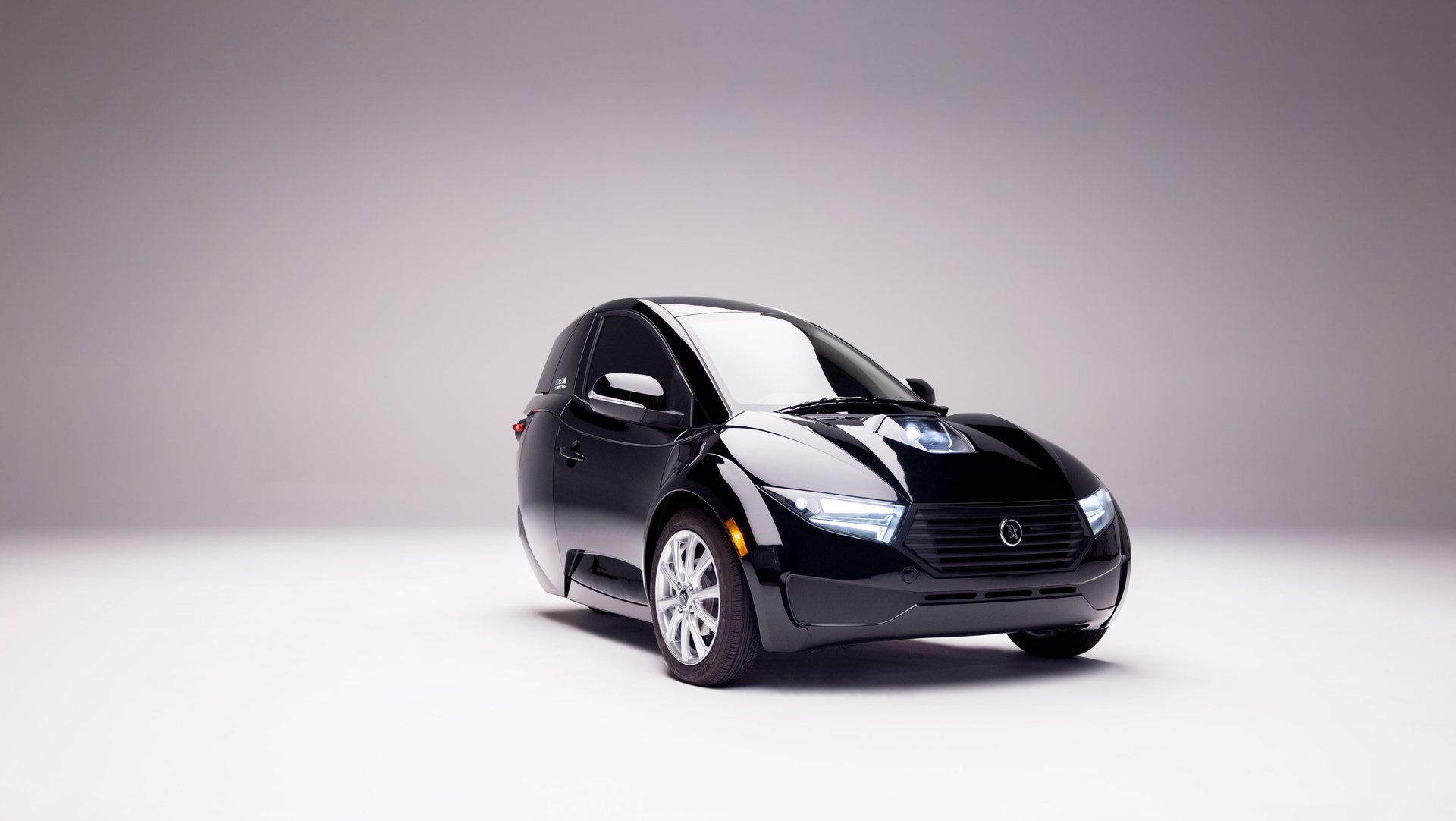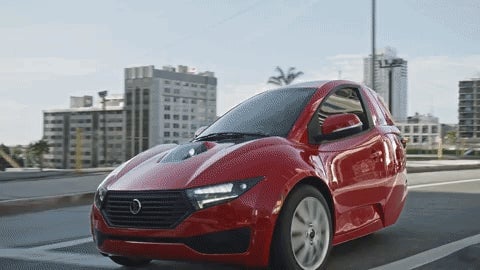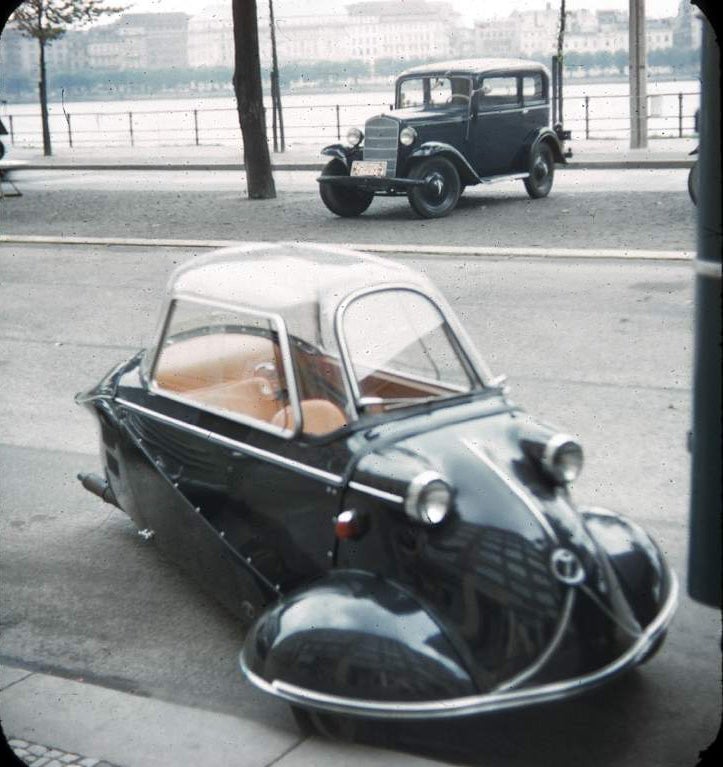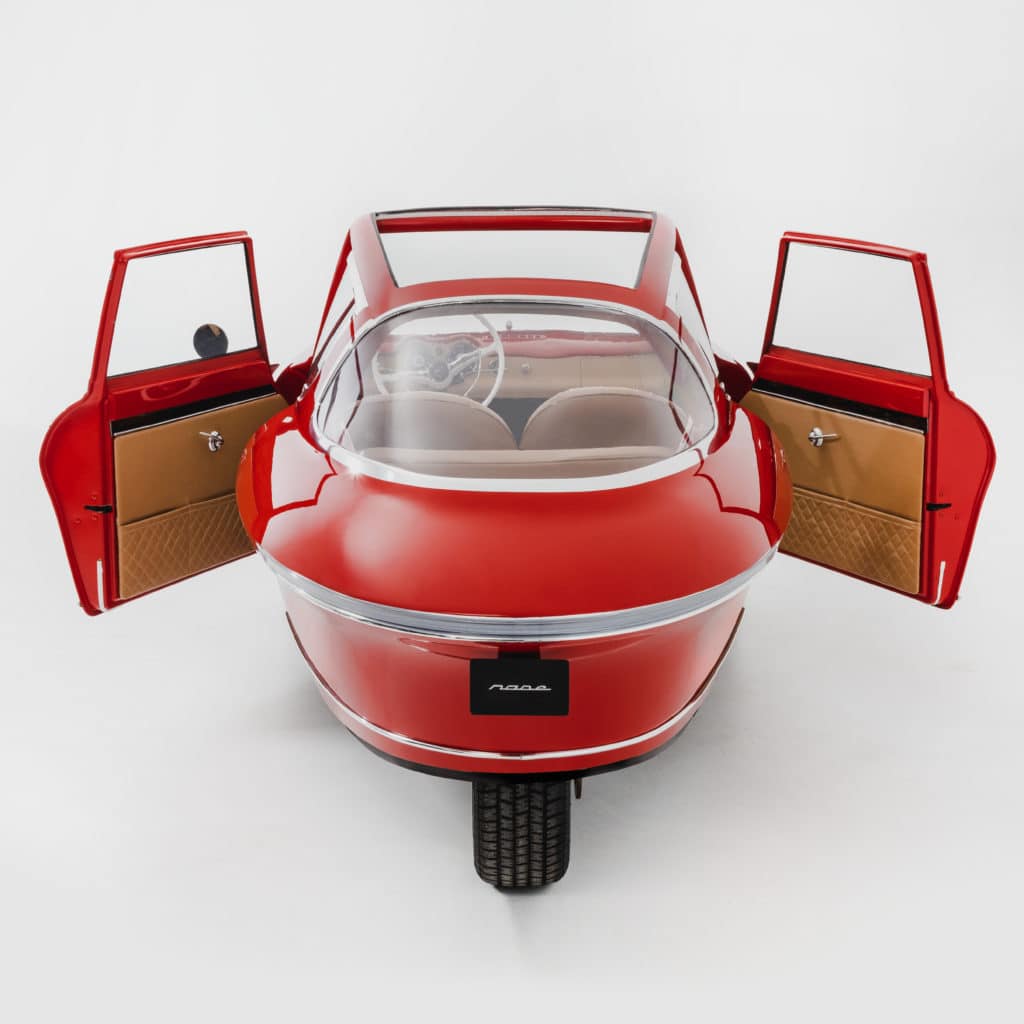Three-wheelers, the punchline of the auto world, are finally having a moment
I press down on the pedal, and the back of my three-wheeler rears up as if to fling me into the street. The hum of the electric motor kicks up a few notches—as does my grip on the steering wheel—but the vehicle glides smoothly into traffic without incident. More than a few heads turn, and while I can’t tell if the SUV and delivery-truck drivers are looking on with envy or amusement, I’m having enough fun to ignore them as I floor the accelerator (0-60 mph in 10 seconds) in my little pie-shaped slice of the future.


I press down on the pedal, and the back of my three-wheeler rears up as if to fling me into the street. The hum of the electric motor kicks up a few notches—as does my grip on the steering wheel—but the vehicle glides smoothly into traffic without incident. More than a few heads turn, and while I can’t tell if the SUV and delivery-truck drivers are looking on with envy or amusement, I’m having enough fun to ignore them as I floor the accelerator (0-60 mph in 10 seconds) in my little pie-shaped slice of the future.
At least, this is the future envisioned by people like Electra Meccanica CEO Paul Rivera, who lent me one of the company’s new Solo vehicles to test drive one morning in March. For 20 minutes, I bobbed and weaved through the streets of Walnut Creek, a wealthy enclave not far from San Francisco.

As vehicles go, the three-wheeler is a historical loser. It’s been tried, and dumped, numerous times since the 1700s. But transportation is undergoing its most radical makeover in a century. A new generation of electric vehicles (EVs) is hitting the streets promising low cost and lots of fun—some on three wheels.
A former executive at the engineering firm Ricardo, Rivera once helped global automakers develop new vehicles. He noticed they were always doing one thing: supersizing vehicles to carry the maximum number of passengers and payload they might ever need.
Rivera saw an opening in the market. “What clicked for me is that [three-wheelers] are so completely different than everything else out there trying to compete with Tesla,” he says, noting that most EVs are either full-sized cars and SUVs, or micro-mobility options like scooters. “It’s really about occupying that space in the middle.”
Electra Meccanica’s new Solo fits that niche. The $18,5000 vehicle offers a 100-mile range on a single charge, and a much lower price tag than a conventional EV (the median EV range in 2020 was more than 250 miles). Still, these cars aren’t for everyone. Driving the Solo feels like sitting in a very narrow Honda Civic with a cockpit just big enough for my 6’ 2″ frame. Flipping the drink holder down partially obstructs the radio. And for now the Solo is made in China, which shows: The plastic interior exudes bare-bones efficiency.
But Electra Meccanica figures there are more than enough people who want a compact, comfortable, and cost-effective vehicle for commuting, urban rides, or commercial fleets. The Canadian company plans to add room for a second passenger or more cargo in the future, and it just announced plans for a new facility in Phoenix capable of assembling 20,000 vehicles per year (while keeping some of the manufacturing in China). Around half a dozen other vehicle startups are eyeing the same opportunity.
The revenge of the electric trikes
The three-wheel design, now mostly limited to off-road vehicles and museum displays, is actually the original automobile. French inventor Nicolas-Joseph Cugnot built the first one, a lumbering steam-powered conveyance for massive artillery, and then a version to carry passengers, in 1769. After it crashed into a stone wall two years later—one of history’s first motor vehicle accidents—engineers gravitated to the greater stability afforded by four wheels.

It wasn’t until the post-WWII boom that Japanese and European car manufacturers revived the form. BMW, Messerschmitt, and Mazda began manufacturing cheap three-wheelers to get their countries moving again. But the vehicles, neither motorcycle nor car, failed to win over drivers once they had the chance (and income) to buy full-sized vehicles.

Three-wheelers have tried to stage a comeback since then, but most were mere nostalgia: Morgan Motor reprised a 1909 design to release its Morgan Threewheeler in 2011, a $46,000 collector’s item. Only in Southeast Asia, where three-wheel vehicles known as auto-rickshaws became ubiquitous, has the form endured. In India, three-wheelers are already the most common EV on the roads, and most are produced by local manufacturers.
But this time could be different for the West, insists Sandy Munro, a former Ford engineer who runs his own engineering consultancy that helps companies design and launch their vehicles. “I think there’s a big market for three-wheelers,” Munro says. “A lot of people want to get into new vehicles, but the price is a killer.” He rattles off three-wheeler virtues such as low manufacturing costs, unbeatable efficiency (due to less drag and rolling resistance), and, of course, fun.
What about safety? Early three-wheel designs, a triangular “delta” configuration with a single wheel up front, proved particularly treacherous, tipping over on tight corners. Newer designs reverse this precarious configuration, positioning two wheels up front and lowering the center of gravity. The result is a “tadpole” design: two stabilizing wheels in front, and one in the back, as if one had taffy-pulled the car into a teardrop shape. These designs, argues Munro, are safer than a motorcycle, balanced by new anti-roll torque control that keeps the vehicles level (though like motorcycles, these vehicles do not undergo the same crash-testing as four-wheel vehicles).
Drivers wanted, no motorcycle license required
All of this begs the question: Is there really a market for these three-wheeled oddities? Startups are betting it’s just around the corner. Munro, by his count, is now advising five companies developing the vehicles around the world. And this year the public will be inundated with three-wheel options. Aptera Motors, the first mass-produced car capable of running on solar panels alone, is already taking orders. Arcimoto (billed as a “Fun Utility Vehicle”) claims it will achieve the equivalent of 174 miles per gallon. Indigo is releasing two models for under $23,000. And Nobe’s classic 60s styling is there to satisfy retro fans.

So far, data on sales is slim. Companies like Aptera have booked more than 7,500 deposits (a refundable $100) and Rivera says the reception for Electra Meccanica has been enthusiastic. The company set up kiosks at malls along the West Coast to sell its concept, and Rivera says there is a “long waitlist” after people plunked down $250 refundable deposits (he declined to release precise numbers). Even if Electra Meccanica’s vehicle fails to take off with the average driver, Rivera argues that corporate fleet owners and shared mobility firms will be its biggest customers once they see the cost savings over conventional vehicles.
But Eric Ibara, an executive analyst at Kelley Blue Book, says three-wheelers like the Solo will still have a hard time breaking into the mainstream. Pricing is comparable to some traditional four-wheel vehicles, while the small batteries, restrictive seating, and promise of “safer than a motorcycle” (but not a car) will limit potential buyers, although niche applications—campuses, retirement, last-mile deliveries—might prove useful. “In order to make a dent into vehicle sales,” Ibara wrote by email, “they would have to appeal to a compact car or subcompact SUV buyer, and I just don’t see that right now.”
Clarification: Electra Meccanica plans to move its final assembly to the US, while keeping most of its parts and other manufacturing in China.